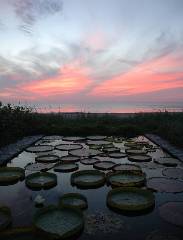 |
 |

|
|
|
||
The first third of 2005 was spent digging out the garden and rebuilding the house after the 2004 hurricanes. Victorias necessarily took a back seat. Unlike other years, we had no time to start any but a few seeds on purpose. We had to rely on spontaneous sprouts. Those got planted and the tough ones made it with little attention from us.
Something happened to the 2004 seeds (collected before the
storms) in storage, which has us revisiting "What
Makes Victoria Seeds Sprout -- Or Not". Victoria has
again found a way to baffle us.
Early in the year, Jeremie Fant of Chicago Botanic Garden and Keith Hartley of Lake Forest College completed a fascinating DNA study of the species plants in our breeding program. Their conclusions were that even some we had found suspicious are indeed pure. See their study and 2003 A New Take On Victoria Species Germination & Will The Real cruziana Please Stand Up for background.
In spite of strange germination and a late start, we were able to grow the plants needed to achieve this year's breeding goals. Primary in this was to bring at least one plant of the Argentine cruziana seeds collected by Walter Pagels and Jorge Monteverde in 2002 to bloom and seed. One of these plants matured seed early in the season and a second came along later. For the fourth year we grew an original Paraguayan cruziana (see 2001 Seeds of the Century). Rounding out the cruziana complement were a second generation Paraguayan and a domestic.
|
In June, the plants grew > In July and August, a juvenile bald eagle used Reflection as a watering hole (More images) >> |
 |
 |
Though the first Argentine cruziana stopped blooming and went into serious decline mid-season, we "chopped and dropped" it. It revived to bloom again and gave us one opportunity to cross it with the other Argentine. We did obtain a few seeds. The plant, though very small, is still alive in late December.
As always, it proved difficult to keep amazonica straight lines going. Though two of them seemed stronger than others, only one produced another generation of seeds this year. Three other plants from crossed lines were installed. Only one produced viable seed. 'Adventure' was as usual the centerpiece of Reflection and 'Longwood Hybrid' tried to outmuscle N. 'Wood's Blue Goddess' in the Victoria pool.
 The
Longwood provided us with an interesting lesson in the difference
between how we humans perceive day length and how plants perceive
day length. For several years, we have been stumped when healthy
Victorias, planted early in the Victoria pool, declined as the
days were still lengthening, dying at the height of the season!
See Tracking C47-B.
Could it be that, even though there was more light for longer,
it was being blocked by the house in the morning? This year we
waited until the days began to shorten again (also as the house
gradually blocked less light) before planting the Longwood and
it thrived. Unfortunately it overgrew quickly and declined quickly.
The
Longwood provided us with an interesting lesson in the difference
between how we humans perceive day length and how plants perceive
day length. For several years, we have been stumped when healthy
Victorias, planted early in the Victoria pool, declined as the
days were still lengthening, dying at the height of the season!
See Tracking C47-B.
Could it be that, even though there was more light for longer,
it was being blocked by the house in the morning? This year we
waited until the days began to shorten again (also as the house
gradually blocked less light) before planting the Longwood and
it thrived. Unfortunately it overgrew quickly and declined quickly.
Our amazonicas were WAY behind our cruzianas so, though we collected a fair number of seeds, most were cruziana and we produced few hybrids. Our yield per pod was also greatly reduced for reasons we don't understand. By not having small plants stalled and carried over the winter as we did in 2003-4 (see Survivor Paradise), we have some new thoughts on the benefits of that, explored in "The Tortoise or the Hare?".
At the end of October, wind from Hurricane Wilma and the cold front that pushed the worst of the hurricane away from us badly damaged the plants and essentially ended our season. We had a few flowers after that on plants that had been installed late or that had been "chopped and dropped" early. Since we had the space, we installed a young 'Adventure' and 'Longwood Hybrid' in Reflection to see if their very youth could carry them through the winter. They are actually still slowly increasing in size at the end of December.

